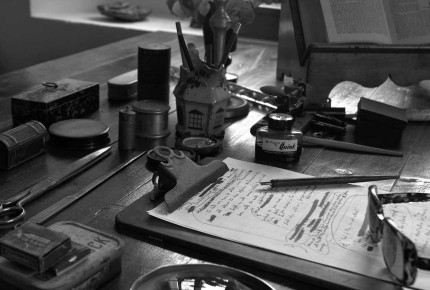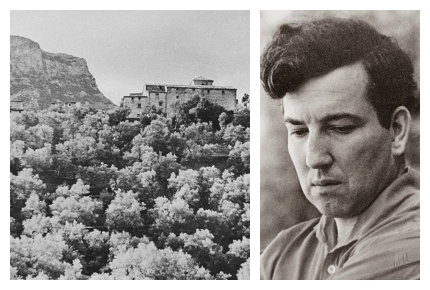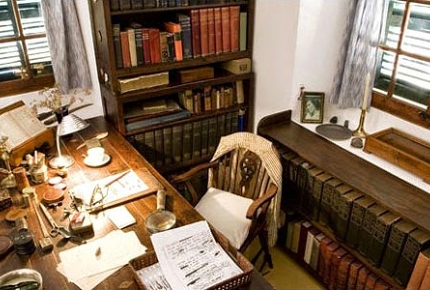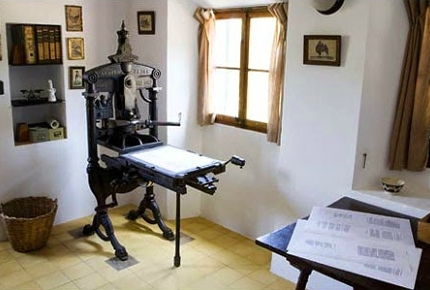Mallorca: A poet’s pilgrimage

The writing desk of Robert Graves in Mallorca
La Casa de Robert Graves
Gavin Haines heads to the Mallorcan mountains, which inspired prodigious prose from one of Britain’s seminal writers.
My taxi wheezes up winding mountain roads and into the fertile hills of Mallorca. In the valley below, clouds cling to terraced slopes, where orange and lemon trees groan under the weight of their bounty.
It starts to rain and suddenly the blue skies and sunshine I woke to in Palma seem a long way away. Heavy droplets drum on the cab roof. By the time we arrive in the village of Deià, it’s chucking it down.
The taxi halts outside a rambling stone villa, surrounded by olive trees, orange groves and neatly pruned hedges. This is the home of the late English poet and novelist, Robert Graves, who eloped here to seek solace and inspiration after a tumultuous adult life that began in the trenches.
It would be Graves’ 120th birthday this Friday (24 July), were he still alive, and I have travelled here to discover more about this extraordinary writer.
Greeting me at the front gate, huddled beneath an umbrella, is the writer’s son, William, and his wife, Elena, who, very sweetly, usher me out of the rain and into a stone outhouse, where rows of chairs face a projector screen.
On one of the walls is a timeline that gives literary pilgrims a condensed chronology of Robert Graves’ colourful life. “It’s based on the Keates timeline, but the poor bugger died at 29 whereas Robert went on to 90,” explains William.
William plays a short video about his father’s life: from his early years in South London to his final days in Deià, via WWI, several turbulent relationships and various literary milestones. But it merely scratches the surface: the real stories lie inside the house.
 Deià church in 1935 and Robert Graves himself
Deià church in 1935 and Robert Graves himselfFundació Robert Graves
The shadow of death
Robert Graves was born in 1895 to a middle class family in Wimbledon. His father was a school inspector with English and Irish blood and his mother came from German nobility. Despite his affluent upbringing, Graves’ early years were anything but comfortable: pneumonia and measles nearly killed him aged seven, and a lingering lung condition blighted his youth.
Worse was to come. In 1914 Graves went to fight in WWI and was critically injured during the Battle of the Somme. The surgeon thought he was a goner and left him for dead… and on his birthday, too.
“He was left in the corner as a gone case,” says William, walking me to the house. “Incredibly he survived.”
By the time the wounded soldier returned to London, The Times had reported his death. Graves set them straight and the newspaper printed a correction, which is displayed inside the house.
Graves spent the rest of the war in England, fearful of being mistaken for a German spy. “His grand uncle was Leopold von Ranke, a well-known German historian, and he was afraid that a fellow officer might shoot him in the back thinking he was a spy,” says William, in Spanish-flecked Queen’s English.
Graves survived the Great War, but he was mentally and physically scarred. “He never really recovered,” says William. “Even when he was becoming senile, if he heard a big bang it would shock him.”
 La Casa de Robert Graves in Deià, Mallorca
La Casa de Robert Graves in Deià, MallorcaLa Casa de Robert Graves
Writing got him through the difficult post-war years, which saw him marry Nancy Nicholson and enrol at Oxford University to study English. “She was a feminist, which didn’t help,” says William, a reference, perhaps, to Nicholson’s openness to a ménage à trois with Graves and the poet, Laura Riding.
Riding and the Graves family (which included four children, no less) moved into a house in Wimbledon, where Riding tried to top herself. “She took a drink of Lysol and jumped out of the window,” says William. “After that she had to leave the UK because it was illegal to commit suicide.”
Graves and Nicholson split soon after, leaving him and Riding free to elope to the bucolic Mallorcan countryside. It was 1929 and he had just written Good-Bye To All That, his “bitter leave-taking of England,” which focuses on his harrowing experiences of WWI and the societal changes that swept across Britain after it.
William leads me into Graves’ study, where shelves strain under the weight of books. The room is just how he left it: piles of paper, many of them first drafts, litter the desk. A paintbrush sits next to dog-eared manuscripts, which Graves used to delete passages he wasn’t happy with.
“The whole point of using a paintbrush was that he was not just scratching the words out but erasing them, because he found them distracting,” says William.
 Graves’ study, where first drafts still litter the desk
Graves’ study, where first drafts still litter the deskLa Casa de Robert Graves
Picking up the pieces
The outbreak of the Spanish Civil War in 1936 forced Graves and Riding to abandon their Mallorcan bolthole (paid for with profits from his seminal novel, I, Claudius) and move back to London. “With all this money coming in from I, Claudius they then went to live in Switzerland to avoid tax,” says William.
Jealous of her partner’s success, Riding left Graves and headed to the USA, where she fell in love. “Robert was devastated,” said William. “But Beryl Hodge (the wife of his literary friend, Alan Hodge) picked up the pieces.”
After the civil war, and the Hodges’ civil divorce, Graves and Beryl moved to Deià, where they had four children.
“We weren’t allowed to make any noise at all – he had to work in silence,” recalls William, the eldest of the four. “By the 1960s he couldn’t get away from the noise – there were children, cars going by, celebrities dropping in, tourists visiting – so he rented a little sheep hut in the mountains.”
When Graves wasn’t writing, he would go sea swimming, exchange letters with fans, including Spike Milligan, and tend his garden. “He was not a man of leisure,” says William.
He kept his hard-earned cash in a hollowed-out book of poetry, which is on display inside the house. “There’s no poetry in money and no money in poetry,” he would opine, though the cheques kept rolling in.
As the rain dies off, I leave William where I found him, at the front gate. He kindly gives me an orange from one of the trees, planted by his father. “For the journey back to Palma,” he says, smiling.
Rather than heading straight back to Palma, I take a detour to Deià cemetery. I walk around the terraced necropolis, scanning the headstones, until I find one inscribed with the word poeta. It belongs to Robert Graves, of course. This modest plot is where the great writer wanted to be buried, where he finally said goodbye to all that.
 Robert Graves' house is much how he left it
Robert Graves' house is much how he left itLa Casa de Robert Graves
NEED TO KNOW
Getting there
easyJet runs regular services to Palma, the Mallorcan capital, from London Luton, Stansted and Gatwick (www.easyjet.com).
Staying there
Hotel d’es Puig (www.hoteldespuig.com) is located a short walk from Robert Graves’ house in Deia. The boutique hotel has fine views of the Tramuntana mountains, plus an outdoor swimming pool.
More information
www.lacasaderobertgraves.org
www.palmademallorca.es
Liked this? Then have a gander at these:
Top 10 poetry pilgrimages
The 15 weirdest wellness retreats
Do you have any Feedback about this page?
© 2025 Columbus Travel Media Ltd. All rights reserved. No part of this site may be reproduced without our written permission, click here for information on Columbus Content Solutions.









 You know where
You know where